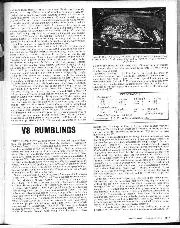
V8 Rumblings, November 1970
There have always been people who inserted engines bigger than the makers intended into basically inoffensive machinery. Doubtless Motor Sport's Editor and D.S.J. could accurately recall countless examples of this…
THE SIZAIRE-NAUDIN CAR
Sir.—Certain ancient owners of the single cylinder Sizaire-Naudin car were very interested in the article written in your August issue on the purchase of one of these cars. Between the three oe four of us concerned, we had about eight of these ears altogether. I had three. We think your contributor has got his facts and history correctly, but there are one or two comments that we should like to add.
Your contributor gives the impression that no car was ever made with a greater bore than 120 mm., and to all intents and purposes he is correct, but they did make a special car for hill-climbing competitions with a bore of 140 and a stroke of 170, and I bought this car from Mr. Lwellyn Scholte about the year 1911 or 1912. This car would do down slopes about 65 m.p.h., and the ordinary standard model would do about 55 and they climbed hills almost like motor bicycles. Your correspondent’s description would not be complete without the mention of the throttle control by means of varying the lift of the overhead inlet valve, and be correctly gives considerable space to this feature. We do not think, however, that he praises it quite enough. It was an extraordinarily simple and very satis
factory operation, and did away with a 16t of small parts and made the carburetter very simple, and it was also a very economical method as regards petrol consumption. His car is no doubt suffering from ” anno domini,” but when in good order, there was no trouble about starting the engine on the half compression, it would fire indefinitely thus and one did not have to run round to the steering wheel to move the control over, through this position and to a point on the lower range of
the inlet valve opening, when the engine would turn over very slowly, better than the best tuned up single cylinder motorbicycle engine. We do not remember dual ignition, and think this must have been fitted subse quently, to the best of our recollection there was only the high tension magneto which was mounted with exposed gear wheels as stated. This method enabled the magneto timing to be re-timed very quickly by loosening the strap and mov
ing the wheel one tooth forward or back. Still, it had a drawback, because once the strap on nay car broke and the magneto fell off on to the road and bounded into a thick snow drift between Royston and Baldock, and it took me (in the snow
storm at night) nearly an hour to find it, another hour to bake it in a near-by cottage and a further hour making a means of holding it down in place of the broken strap ! Your correspondent says he has not opened the back axle to find out how the gear Works, but he is correct in his Anticipation of what happens there. It was a very good control and, as he says, gave direct drive on all gears. One other
point that deserves further mention is thf!. clutch, Although the engine was only a single cylinder, one could start it On high gear up a slope without the least shudder, and that. very simple clutch was just about the best clutch that has ever been lit t’:1 to a motor-car.
As yewcorrespondent says, the car was extremely ingenious, far ahead of its time with the construction of the frame and independent front wheel springing, and it is quite fair to say that it was freer of trouble than the average modern car with all its gadgets. It was in fact, a glorified edition of the single-cylinder motor-bicycle. I am, Yours, etc.,
G. R. N. Minchin.
50, Grosvenor Gardens, London, S.W.1.